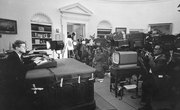Declaring that "Iraq both poses a continuing threat to the national security of the United States and international peace and security in the Persian Gulf region," in October 2002, the U.S. Congress passed Public Law 107-243, titled “Authorization for the Use of Military Force in Iraq Resolution of 2002.” While this resolution granted the president authorization to "use the Armed Forces of the United States as he determines to be necessary and appropriate" regarding Iraq, this was not a formal declaration of war.
Declaring War
Article I, Section 8 of the U.S. Constitution vests in Congress the power to declare war, and since the founding of the republic, Congress has declared war 11 times, the last three declarations approved on June 4, 1942, against Bulgaria, Hungary and Romania, during World War II. Each of these declarations followed a formal presidential request for war, and in the early part of the 20th century, came after "findings by the President that U.S. territory or sovereign rights had been attacked or threatened by a foreign nation," according to the Congressional Research Service. The wars in the which the U.S. has fought since then -- including in Korea, Vietnam, Afghanistan and Iraq -- have been authorized by congressional resolutions.
War Authorizations
After World War II, declarations of war fell out of vogue both in the United States and the international community, replaced by authorizations to use force. Because of treaties and international agreements, such declarations became anachronistic because the rights of states to war with one another has been significantly restrained under international law. In the U.S., the language in these authorizations often granted the president the broad ability to use military force in a specific region of the world. Under more recent legal interpretations, specifically the 1973 War Powers Resolution, the president is seen as having the right to initiate military attacks even without prior congressional approval, though he must soon thereafter consult with Congress and, if Congress does not assent to the military action, withdraw military forces within 60 days.
Legal Distinctions
In the United States, a declaration of war "automatically triggers many standby statutory authorities conferring special powers on the President with respect to the military, foreign trade, transportation, communications, manufacturing, alien enemies, etc.," according to the Congressional Research Service. This is not necessarily so with authorizations to use force. However, following the 9/11 attacks, the Bush administration interpreted Congress's authorization to invade Afghanistan and battle Al-Qaeda more broadly than with an actual war declaration, including the right to use electronic surveillance and detain alleged terrorists indefinitely.
The Iraq Resolution
In September 2002, just a year after the 9/11 terrorist attacks, President Bush asked Congress to authorize the use of military force against Iraq, citing alleged threats to the U.S. by the regime of Iraqi President Saddam Hussein, as well as Iraq’s failure to comply with United Nations disarmament resolutions. Congress passed the resolution a month later, which sent an unambiguous message that “Iraq will either comply with all U.N. resolutions, rid itself of weapons of mass destruction, and ... its support for terrorists, or will be compelled to do so,” Bush declared. Five months later, on March 19, 2003, the U.S. and its allies began invading Iraq. Though one of the Bush administration's oft-cited causes for war was Iraq's possession of weapons of mass destruction, none was found following the regime's deposal.
Related Articles
References
- Government Printing Office: Authorization for the Use of Military Force in Iraq Resolution of 2002
- University of Missouri-Kansas City: War and Treaty Powers
- U.S. Senate: Official Declarations of War by Congress
- Congressional Research Service: Declarations of War and Authorizations for the Use of Military Force: Historical Background and Legal Implications
- History.com: War in Iraq Begins
Writer Bio
Jeffrey Billman is both an experienced and accomplished journalist with national awards for everything from investigative reporting to religion reporting to humor and opinion columns. A student of government and politics, he holds a master's degree in public policy analysis.











